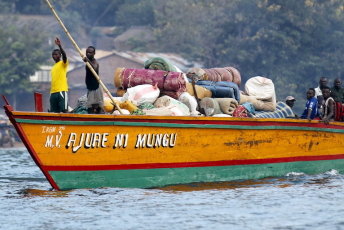Cattle rustling in East Africa leads to the loss of lives and cattle, destruction of property, displacement of communities and threats to public safety. Cattle rustling in East Africa is controlled by ‘cattle warlords’ and is spurred by a rising demand for beef among urban populations in the region and abroad. It is described as an entrepreneurial crime leading to a financial loss for the region of at least US$27 million a year.
Increasing incidents of cattle rustling have been reported in the Warrap, Unity and Lakes States of South Sudan, the Karamoja sub-region in Uganda, north-western counties of Kenya and among the Nyangatom and Daasanach communities in south-western Ethiopia. It often takes less than 24 hours for elaborate networks of criminals to steal livestock, load them onto trucks and transport them to markets or abattoirs in urban centres and across borders. The carcasses of slaughtered livestock bound for overseas markets are then transported using air cargo. A violent crime that once happened under the cover of darkness, cattle rustling now takes place blatantly during daylight hours.
For centuries, cattle raiding among pastoralists in East Africa was a generally accepted cultural practice to acquire livestock to replenish decimated herds after periods of drought. Cattle raiding as an institution of mutual exchange among communities was governed by regulations established by elders to protect life. Warriors sought the blessings of elders and seers in order to successfully raid neighbouring communities.
Raiding was seen as the job of a warrior. It was used as a process through which young men (warriors) exhibited bravery that was key to defending community property (livestock and territory). Raiding was also important for warriors as it was the only means through which livestock was acquired for the payment of bridewealth. Raids therefore involved combat between warriors from opposing communities. Women, children and the elderly were never targeted.
Cattle raiding changed when communities in the region started acquiring illicit firearms trafficked from neighbouring countries such as Ethiopia in the 1980s. Guns weaponised the conventional raiding and through force, enabled the acquisition of large herds of livestock, which precipitated commercialised cattle raiding. The use of automatic weapons such as AK47s and M16s saw the cultural practice of cattle raiding evolving into cattle rustling – a violent organised criminal enterprise aimed at acquiring cattle from pastoralists’ lands for commercial gain.
Eric Kioko, a social anthropologist at Kenya’s Kenyatta University, told ENACT that the ‘high’ season of cattle rustling in Kenya occurred at the onset of the rains, between August and October, when herders moved from dry-season pastures to community-owned pastures. As pastoralists moved back home, there is always a higher propensity for raids to enable the replacement of decimated herds.
Arms smugglers ensure that supply meets the high demand for illicit arms and ammunition during this time. Kioko adds that bullets for the AK47 rifle are sold for as little as US$1 each during the high season.While adult warriors conducted cattle raids in the past, it is now the youth who are involved in the current cattle rustling. Most of these young cattle rustlers have little formal education and limited opportunities for alternative livelihood options.
Evans Onyiego, an independent researcher, told ENACT that proceeds from rustling enable the youth to acquire cellphones and even motorbikes, which they see as a socio-economic achievement. The youth who are hired as cattle rustlers are sometimes paid in cash or through mobile money transfers, or given a particular number of livestock as compensation.
With the introduction of firearms, organised criminal groups have increasingly recruited and used underage children to conduct cattle raids. Cattle rustling has also been connected to human trafficking. In South Sudanese pastoralist communities, those involved in cattle rustling sometimes abduct young girls who are later raised to be members of these communities and married off to younger warriors. This is recognised as a serious regional security threat. There have been both bilateral and unilateral efforts to eradicate cattle rustling by affected countries in East Africa.
Kenya and Ethiopia signed a peace agreement to end cross-border cattle rustling in 2009. In 2012 Uganda deployed more the 5 000 soldiers along the Uganda-Kenya border to stop cross-border raids. In September 2019, Kenya and Uganda signed a memorandum of understanding for sustainable peace in the Karamoja cluster, a geographical area at the borders of Uganda, Kenya, Ethiopia and South Sudan inhabited by pastoralist groups.
A regional approach developed by East African states in 2008, the Mifugo Protocol, was unsuccessful, having been signed only by Uganda and never implemented.
To ensure success, tackling cattle rustling in East Africa requires a regional legislative and development framework that addresses not only the urgent security challenges but also the historical marginalisation of pastoralists. In addition, a critical success factor will be policy interventions in the region that strive to entrench inter-state cooperation and intelligence sharing on the movements of livestock herders and their arms from one country to another.
In conjunction, addressing the historical marginalisation of pastoralists in East Africa is equally important. The provision of state security to guarantee public safety and reduce the illegal ownership of small arms and light weapons are two imperatives to changing this current insecurity. The development of transport and communication infrastructure is also key to enabling citizens to access legitimate livestock markets.
Providing public services such as healthcare, water and education would further enhance the capacity of pastoralist households to exploit opportunities in other sectors. This would require robust partnerships between governments, civil society and development actors in community education, including vocational training for pastoralist warriors. These could enhance livelihood options for the youth and encourage them to pursue alternative means of production to cattle rustling.
These suggestions for creating more peaceful pastures in the region will require the leadership in communities, local and county governments, and among the affected states. The revitalised Mifugo Protocol to prevent, combat and eradicate cattle rustling in Eastern Africa is an opportunity to shape and implement this.
Willis Okumu, Senior Researcher and Mohamed Daghar, Regional Coordinator, Eastern Africa, ENACT Project, ISS









